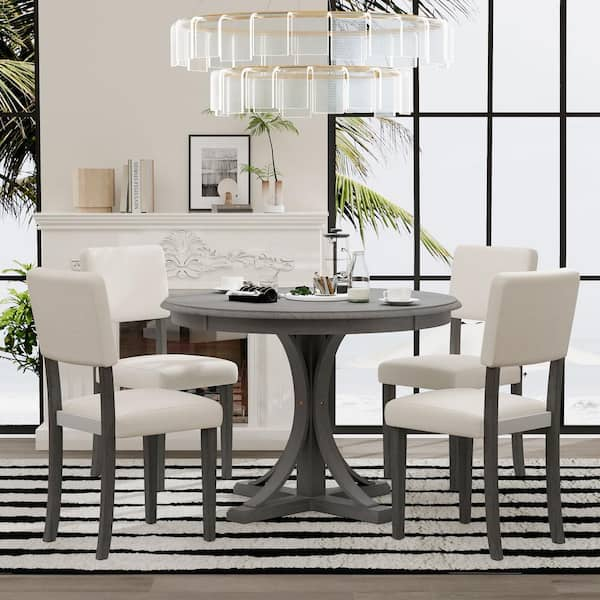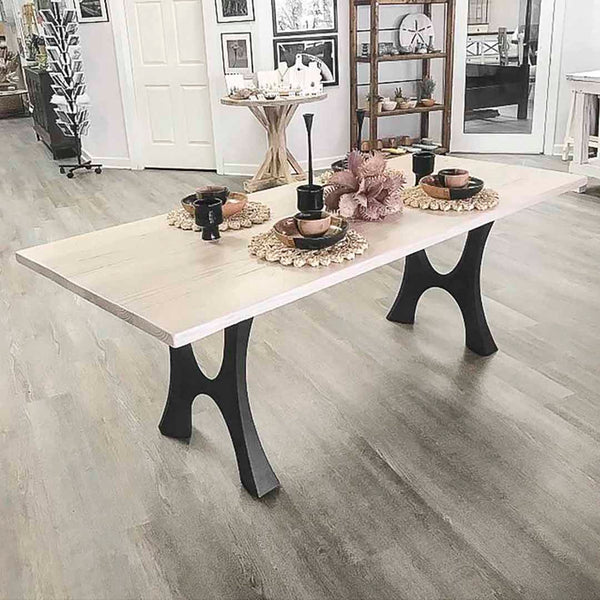Upgrade Your Furniture with Custom Dining Room Table Legs
Upgrade Your Furniture with Custom Dining Room Table Legs
Blog Article
Just How to Pick the Perfect Dining Area Table Legs for Your Home Decoration
Selecting the ideal dining room table legs is a nuanced procedure that calls for cautious factor to consider of numerous aspects, including your room restrictions, aesthetic preferences, and functional demands. The interplay in between materials, designs, and dimensions can dramatically affect the setting of your dining location, making it crucial to approach this choice carefully.
Assess Your Eating Room
Evaluating your eating room is important for choosing the right table legs that enhance both looks and functionality. Begin by determining the dimensions of your eating location, including ceiling height, floor area, and closeness to other furniture. This details will certainly assist determine the appropriate size and elevation of your table, which directly affects the option of table legs.
Next, think about the style and design of your eating room. An open-concept layout may profit from table legs that supply aesthetic agility, such as slender steel or acrylic options. On the other hand, an extra typical setting could call for strong wood legs that supply a sense of permanence.
Review the existing shade scheme and products in your eating area. Harmonizing the table legs with these elements creates a cohesive look that enhances the total design.
Eventually, a thorough assessment of your eating room will certainly assist you in making an educated choice, guaranteeing that your table legs not only enhance the visual appeal yet likewise offer useful purposes.
Consider Your Style Preferences
When selecting dining-room table legs, it is necessary to review your individual style preferences, as they substantially affect the total visual of your dining room. Your choice of table legs can either complement or contrast with existing decoration, making it vital to straighten them with your favored indoor style theme.
If your home leans towards a modern-day aesthetic, consider smooth steel or minimal wooden legs that give a tidy, clean look. For an extra traditional approach, luxuriant wooden legs with detailed carvings can include a touch of beauty and class. Industrial styles gain from durable, basic materials such as redeemed wood and metal combinations, mirroring a rugged beauty.
Additionally, farmhouse and rustic designs typically favor tough, chunky legs that stimulate a sense of warmth and convenience. Conversely, if your decor is diverse, you might select unconventional shapes or a mix of products to create visual passion.

Evaluate Product Options
The option of product for dining room table legs plays a crucial duty in both sturdiness and aesthetic allure. Common materials consist of timber, metal, and composite alternatives, each offering unique attributes that can influence the general look and longevity of your table.
Timber is a traditional choice, recognized for its heat and flexibility. Hardwoods like oak and walnut give outstanding stamina and can be completed in various stains to match any type of design. Softwoods like yearn are much more prone to scrapes and dents, making them less excellent for high-traffic locations.
Metal legs, commonly crafted from steel or aluminum, radiate modernity and industrial beauty. They are very sturdy and immune to use, making them appropriate for households with kids or frequent celebrations (dining room table legs). Furthermore, metal can be ended up in different colors, improving the modification possibilities
Composite materials, such as MDF or laminate, deal cost and varied styles. While usually less durable than strong wood or steel, they can still supply a trendy look and are commonly very easy to preserve.
Eventually, the product you choose need to straighten with your way of living, aesthetic choices, and the degree of usage your table will certainly experience.
Determine Height and Dimension
Choosing the appropriate elevation and size for your dining-room table is essential for both capability and comfort. The standard elevation for eating tables usually varies from 28 to 30 inches, enabling ample legroom for a lot of individuals when seated. Nevertheless, it is vital to think about the measurements of your dining area and the kinds of chairs you plan to utilize.

In addition, consider the proportions of your dining-room. A bigger table in a sizable location can develop a grand setting, while a smaller sized table works well in even more intimate setups. Inevitably, the appropriate elevation and dimension will certainly integrate with your total decor and enhance the eating experience for you and your guests.
Explore Modification Opportunities

Furthermore, the design of the legs can be customized to fit numerous styles, such as rustic, modern-day, or industrial. For example, conical discover this info here legs can evoke a mid-century modern feeling, while chunky, block-style legs might resonate with traditional or farmhouse style.
House owners can likewise discover shade finishes, from all-natural wood discolorations to paint, allowing them to match or contrast with the tabletop and bordering style.
Moreover, leg elevation can be gotten used to suit particular seating setups or personal preferences, improving both convenience and performance.
Lastly, special embellishments, such as carvings or attractive brackets, can additionally individualize the table legs, making the eating experience not just a declaration but a meal item in the home. By taking into consideration these modification options, house owners can develop a dining-room table that absolutely reflects their uniqueness.
Verdict
Choosing the ideal dining-room table legs calls for careful consideration of different variables, including the dimensions of the eating space, style choices, product resilience, and preferred elevation. Modification alternatives further boost the capability to achieve a cohesive visual that matches the total style. By systematically evaluating these elements, home owners can guarantee that the selected table legs not only fulfill functional requirements but also contribute positively to the eating experience and atmosphere of the home.
Choosing the perfect eating area table legs is a nuanced procedure that requires careful factor to consider of various elements, including your space constraints, aesthetic preferences, and practical demands.Analyzing your eating room is essential for selecting the right table legs that complement both aesthetic appeals and performance.When identifying size, measure the location where the table will certainly be put to ensure it fits pleasantly, permitting for at least 36 inches of clearance around the table for very easy activity. A larger table in a roomy location can develop a grand atmosphere, while a smaller table functions well in more intimate setups.Choosing the perfect eating room table legs calls for careful consideration of numerous elements, including the measurements of the dining room, design preferences, product sturdiness, and preferred height.
Report this page